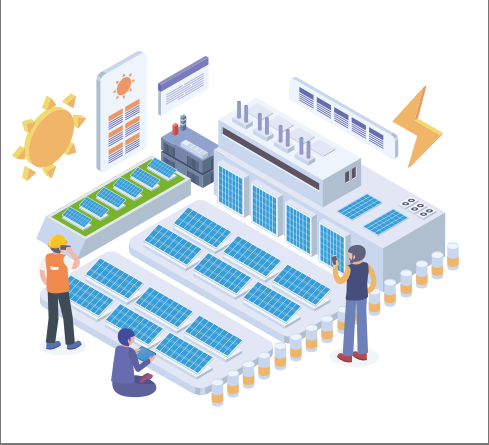Distributed photovoltaic five kinds of investment operation mode, which one is suitable for you?
With the continuous development of China's industrial industry, the contradiction between environmental protection and energy supply is becoming more and more prominent, solar photovoltaic power generation as a renewable and clean energy source has been vigorously developed, and in recent years, the total amount of installed photovoltaic power generation in China has ranked first in the world. However, affected by the shortage of land resources, distributed photovoltaic power plants have been developing rapidly in recent years due to the convenience of connecting to the grid and the flexibility of the site, and more and more industrial and commercial plant roofs have begun to install distributed photovoltaic power plants.
Recently, LIBERTECH has cooperated with JA Solar to build a green demonstration factory around Xinxiang LIBERTECH Industrial Co., Ltd. and the first phase of the 3.7MWp rooftop distributed photovoltaic power project has been successfully connected to the grid and put into use. The project, which uses JA Solar's module products, is planned and executed by JA Smart Energy. The completion of the project not only reduces the internal energy consumption of the factory, but also improves the working environment of the workers, and effectively alleviates the tense situation of power supply during the summer peak season, thus successfully setting up a quality model for the in-depth integration of new energy sources and the manufacturing industry.
Next, JA Azure will bring you to understand the five investment operation modes of distributed PV projects, come to see which one is more suitable for you?
Self-investment Mode
Enterprises invest in distributed photovoltaic projects for their own plant roofs, and through the design, procurement and construction bidding, ensure that the project is carried out by a professionally qualified general contracting company. During the pre-construction and post-operation and maintenance phases of the power plant, the enterprise will carefully select PV companies with professional capabilities to ensure the smooth progress of the project. This type of investment does not involve project financing.
Bank Loan
Green PV loans are loan products designed by commercial banks especially for distributed PV projects, with a wide range of borrower groups, including both individual owners and PV enterprises. The main purpose of such loans is to cover the cost of purchasing PV power plant equipment, while the source of repayment relies mainly on household income, state subsidies, and proceeds from residual power feed-in. According to the preliminary statistics of Hainan Green Finance Institute, up to now, 121 banks in 19 provinces and cities have successfully carried out green PV loan business.
Finance Lease
At the starting stage of the project, the owner negotiates with the PV product manufacturer to determine the required number of module products, specifications and other key parameters. At the same time, the owner will sign a clear lease agreement with the financial leasing company. According to the agreement, the leasing company will be responsible for purchasing the required equipment and handing it over to the owner for the construction of the power plant. When the construction of the power station is completed, the owner will pay the rent of the financial leasing company by obtaining the income from electricity tariffs. The forms of financial leasing mainly include direct leasing and sale and leaseback. Under the direct leasing mode, the leasing company undertakes all the investment during the construction period of the project, which significantly reduces the economic pressure of the owner at the initial stage and effectively solves the problem of initial financing. This mode is especially suitable for industrial and commercial enterprises with their own plants. During the whole process, PV development and operation enterprises are mainly responsible for the procurement of power generation equipment, installation of power generation devices and signing operation and maintenance agreements with owners and users. Typically, these companies do not directly hold ownership of the power plant.
Third Party Investment and Operation
The investor signs a Rooftop Rental Contract and a Power Purchase and Sale Agreement with the business owner, stipulating that the investor will be responsible for financing and constructing the rooftop PV project, and agreeing to give the business owner a discounted tariff on the portion of PV power generated by the business owner for its own use. Under this model, the investor will receive significant revenue, while the business owner will be limited to enjoying the financial benefits from the discounted tariff. The distribution of carbon revenues is clearly agreed upon by both parties in accordance with the terms of the contract. The investor may also lease the building and pay the owner an annual rental fee for the roof area and its rental price, while the owner will only receive the economic benefits of the lease. The distribution of carbon revenue is also to be explicitly agreed upon by both parties in accordance with the terms of the contract.
Government Franchise
The Distributed PV Government Franchise model is a government-private sector partnership designed to facilitate the development, construction and operation of distributed PV projects. In this model, the government grants a concession to a private company or project company for a certain period of time to utilize government assets (e.g., rooftops of public buildings) for the construction of PV power plants. The government or public agency grants the right to use selected rooftop resources to the project company, allowing it to build and operate the PV project for a certain period of time; the project company is required to pay a concession fee to the government, which may be a fixed fee or based on a certain percentage of the project's revenues; the project company is responsible for the entire investment, design, construction, and commissioning of the PV power plant, and ensures that the project is completed on time and meets the pre-determined technology and performance standards, with




